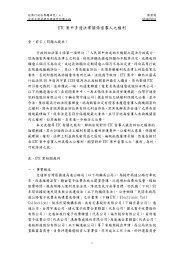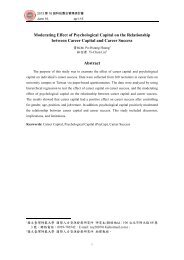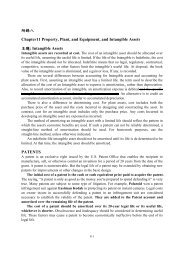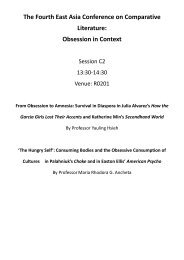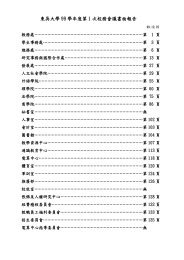The Power of the Pill: Oral Contraceptives and Women's ... - Mail
The Power of the Pill: Oral Contraceptives and Women's ... - Mail
The Power of the Pill: Oral Contraceptives and Women's ... - Mail
You also want an ePaper? Increase the reach of your titles
YUMPU automatically turns print PDFs into web optimized ePapers that Google loves.
power <strong>of</strong> <strong>the</strong> pill 759<br />
measures <strong>of</strong> career <strong>and</strong> marital status outcomes for single year <strong>of</strong> birth<br />
cohorts <strong>of</strong> college women to <strong>the</strong>ir access to <strong>the</strong> pill <strong>and</strong> abortion when<br />
young.<br />
<strong>The</strong> unit <strong>of</strong> observation in our empirical analysis is an age/year cell<br />
(or, equivalently, a year <strong>of</strong> birth/calendar year cell). We examine 20 age<br />
groups (ages 30–49) across <strong>the</strong> three census years (1970, 1980, <strong>and</strong><br />
1990), yielding 60 observations (derived from 133,126 micro observations<br />
in <strong>the</strong> three censuses) <strong>and</strong> covering <strong>the</strong> 1921–60 birth cohorts <strong>of</strong><br />
U.S.-born college graduate women.<br />
Our basic estimating equation has <strong>the</strong> form<br />
Y p a d X b P g A p e ,<br />
at a t at at at at<br />
where a indexes age <strong>and</strong> t census year; <strong>the</strong> dependent variable Y at measures<br />
<strong>the</strong> share <strong>of</strong> age group a (or, equivalently, <strong>of</strong> year <strong>of</strong> birth cohort<br />
y, where a y p t) experiencing a particular career or marital status<br />
outcome in year t; X at contains controls for race; P at is a measure <strong>of</strong><br />
access to or usage <strong>of</strong> birth control for cohort members as young women;<br />
A at is a measure <strong>of</strong> access to or usage <strong>of</strong> abortion for cohort members<br />
as young women; <strong>the</strong> a a are a full set <strong>of</strong> age dummies; <strong>and</strong> <strong>the</strong> d t are a<br />
full set <strong>of</strong> census year dummies.<br />
<strong>The</strong> basic idea behind <strong>the</strong> specification is to observe successive cohorts<br />
at <strong>the</strong> same age to examine whe<strong>the</strong>r between-cohort changes in career<br />
<strong>and</strong> marital status outcomes are related to between-cohort changes in<br />
access to <strong>the</strong> pill <strong>and</strong> abortion for young single women, controlling for<br />
preexisting trends in <strong>the</strong>se outcomes across cohorts. <strong>The</strong> specification<br />
is equivalent to controlling for a set <strong>of</strong> unrestricted single year <strong>of</strong> age<br />
(life cycle) effects, a preexisting linear time trend in outcomes across<br />
birth cohorts, <strong>and</strong> a discrete aggregate jump (time effect) for 1990.<br />
We relate <strong>the</strong> career <strong>and</strong> marital status outcomes <strong>of</strong> a birth cohort<br />
to <strong>the</strong>ir actual pill usage (proxied by <strong>the</strong> fraction <strong>of</strong> college women in<br />
a cohort taking <strong>the</strong> pill before age 21 among those with no births before<br />
age 23, as in fig. 1) <strong>and</strong> <strong>the</strong>ir pill access (proxied by <strong>the</strong> fraction in a<br />
cohort born in a state with a nonrestrictive birth control access law when<br />
<strong>the</strong>y were younger than 21 years). We include similar controls for <strong>the</strong><br />
abortion rate (for all women ra<strong>the</strong>r than college women) when each<br />
cohort was in college (aged 18–21 years) <strong>and</strong> <strong>the</strong> abortion legalization<br />
environment <strong>the</strong>y faced at college entrance (at age 18).<br />
Columns 1 <strong>and</strong> 2 <strong>of</strong> table 5 examine how pill <strong>and</strong> abortion access<br />
affected <strong>the</strong> fraction <strong>of</strong> college women employed in pr<strong>of</strong>essional occupations<br />
(excluding nursing <strong>and</strong> noncollege teaching). <strong>The</strong> estimates<br />
in column 1 show that <strong>the</strong> pill usage <strong>and</strong> abortion rate measures have<br />
similar strong positive effects on <strong>the</strong> share <strong>of</strong> college women employed




